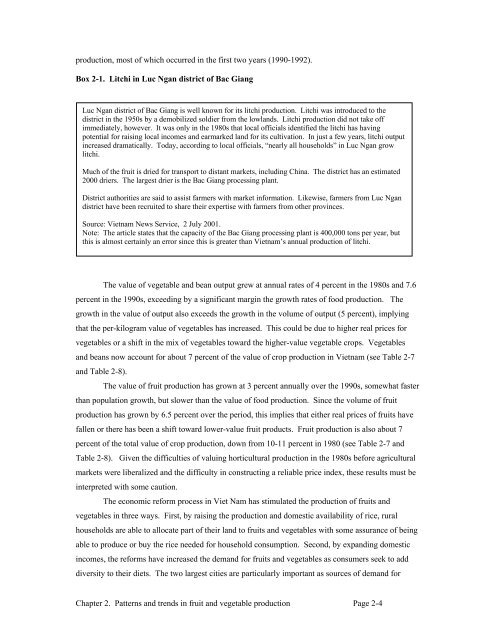Fruits and Vegetables in Vietnam - International Food Policy ...
Fruits and Vegetables in Vietnam - International Food Policy ...
Fruits and Vegetables in Vietnam - International Food Policy ...
You also want an ePaper? Increase the reach of your titles
YUMPU automatically turns print PDFs into web optimized ePapers that Google loves.
production, most of which occurred <strong>in</strong> the first two years (1990-1992).<br />
Box 2-1. Litchi <strong>in</strong> Luc Ngan district of Bac Giang<br />
Luc Ngan district of Bac Giang is well known for its litchi production. Litchi was <strong>in</strong>troduced to the<br />
district <strong>in</strong> the 1950s by a demobilized soldier from the lowl<strong>and</strong>s. Litchi production did not take off<br />
immediately, however. It was only <strong>in</strong> the 1980s that local officials identified the litchi has hav<strong>in</strong>g<br />
potential for rais<strong>in</strong>g local <strong>in</strong>comes <strong>and</strong> earmarked l<strong>and</strong> for its cultivation. In just a few years, litchi output<br />
<strong>in</strong>creased dramatically. Today, accord<strong>in</strong>g to local officials, “nearly all households” <strong>in</strong> Luc Ngan grow<br />
litchi.<br />
Much of the fruit is dried for transport to distant markets, <strong>in</strong>clud<strong>in</strong>g Ch<strong>in</strong>a. The district has an estimated<br />
2000 driers. The largest drier is the Bac Giang process<strong>in</strong>g plant.<br />
District authorities are said to assist farmers with market <strong>in</strong>formation. Likewise, farmers from Luc Ngan<br />
district have been recruited to share their expertise with farmers from other prov<strong>in</strong>ces.<br />
Source: <strong>Vietnam</strong> News Service, 2 July 2001.<br />
Note: The article states that the capacity of the Bac Giang process<strong>in</strong>g plant is 400,000 tons per year, but<br />
this is almost certa<strong>in</strong>ly an error s<strong>in</strong>ce this is greater than <strong>Vietnam</strong>’s annual production of litchi.<br />
The value of vegetable <strong>and</strong> bean output grew at annual rates of 4 percent <strong>in</strong> the 1980s <strong>and</strong> 7.6<br />
percent <strong>in</strong> the 1990s, exceed<strong>in</strong>g by a significant marg<strong>in</strong> the growth rates of food production. The<br />
growth <strong>in</strong> the value of output also exceeds the growth <strong>in</strong> the volume of output (5 percent), imply<strong>in</strong>g<br />
that the per-kilogram value of vegetables has <strong>in</strong>creased. This could be due to higher real prices for<br />
vegetables or a shift <strong>in</strong> the mix of vegetables toward the higher-value vegetable crops. <strong>Vegetables</strong><br />
<strong>and</strong> beans now account for about 7 percent of the value of crop production <strong>in</strong> <strong>Vietnam</strong> (see Table 2-7<br />
<strong>and</strong> Table 2-8).<br />
The value of fruit production has grown at 3 percent annually over the 1990s, somewhat faster<br />
than population growth, but slower than the value of food production. S<strong>in</strong>ce the volume of fruit<br />
production has grown by 6.5 percent over the period, this implies that either real prices of fruits have<br />
fallen or there has been a shift toward lower-value fruit products. Fruit production is also about 7<br />
percent of the total value of crop production, down from 10-11 percent <strong>in</strong> 1980 (see Table 2-7 <strong>and</strong><br />
Table 2-8). Given the difficulties of valu<strong>in</strong>g horticultural production <strong>in</strong> the 1980s before agricultural<br />
markets were liberalized <strong>and</strong> the difficulty <strong>in</strong> construct<strong>in</strong>g a reliable price <strong>in</strong>dex, these results must be<br />
<strong>in</strong>terpreted with some caution.<br />
The economic reform process <strong>in</strong> Viet Nam has stimulated the production of fruits <strong>and</strong><br />
vegetables <strong>in</strong> three ways. First, by rais<strong>in</strong>g the production <strong>and</strong> domestic availability of rice, rural<br />
households are able to allocate part of their l<strong>and</strong> to fruits <strong>and</strong> vegetables with some assurance of be<strong>in</strong>g<br />
able to produce or buy the rice needed for household consumption. Second, by exp<strong>and</strong><strong>in</strong>g domestic<br />
<strong>in</strong>comes, the reforms have <strong>in</strong>creased the dem<strong>and</strong> for fruits <strong>and</strong> vegetables as consumers seek to add<br />
diversity to their diets. The two largest cities are particularly important as sources of dem<strong>and</strong> for<br />
Chapter 2. Patterns <strong>and</strong> trends <strong>in</strong> fruit <strong>and</strong> vegetable production Page 2-4
















